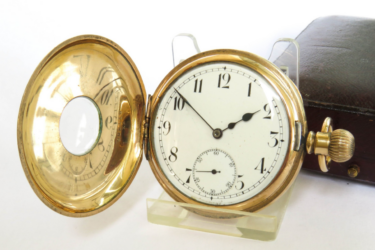A brand reputed as one of the greatest to ever exist, Omega has certainly received its fair share of plaudits. What exactly made this brand one of the best in the business? What is the journey of Omega to get them to where they are today?
Well, without a shadow of a doubt, Omega’s success has been largely due to their well-executed timepieces, their foresight and their fantastic marketing and branding strategies. So where does all this begin for the Swiss brand? Let’s roll our watches back to 1848, where the story begins.
The Early Years

Image Credit: Selling Antiques
Despite nowadays being one of the biggest watch manufacturers in the game, the brand came from very modest beginnings.
Louis Brandt established the company in 1848, and for around thirty years received little-to-no credit for what he had established. Indeed, Louis didn’t see the brand, during his life, grow into anything more than his modest workshop, similar to when he founded the company.
He passed away in 1879, but thankfully his sons saw the promise in what their father had created and relocated the workshop to Bienne. Although Louis Brandt had somewhat of an international clientele, it certainly wasn’t a multinational company. The sons, therefore, tasked themselves with making their father’s dream a reality.
1885 saw the release of their first ever mass-produced calibre which was named the Labrador. And then, nine years later, they invented the 19-line Omega Calibre.
The Brandt brothers had turned their fathers’ workshop into an internationally recognised brand, which after the release of this movement, became Omega. But just when things began to look promising for the two brothers, they both passed away, within a short period of one another. So, all the hard work and dedication that the pair had put into action, now hung by a thread.
The Third Phase…
The next phase of Omega’s history was defined by the presence of Paul-Emile Brandt, who added to the Omega recipe an astute mind for marketing and branding.
This was a fantastic Swiss watchmaker now with international ambitions. The turn of the century saw Omega rise in popularity, largely down to the partnerships that Paul-Emile and co. had put in place.
In particular, they had become the international timekeeper for a balloon race called the Gordon Bennett Cup. This began the long-standing Omega tradition of event sponsorship and clever product placement. Indeed, the next steps for the brand would be a critical turning point in its history.
Qualifying for the Olympics…
1932 was the year Omega made history (for the first time, but certainly not for the last time). The company became the official sponsor of the Olympic Games, becoming the Official Timekeeper, the first time anything of the sort existed for the Olympic Games.
They subsequently went from strength to strength, releasing the Seamaster on their 100th anniversary, in 1948, and this would of course become incredibly popular amongst all kinds of folk, including a certain spy named James Bond. In fact, the appearance on the wrist of James Bond really moved Omega to a pop-culture status and certainly drove the brand’s popularity upwards.
One of the most ground-breaking moments ever and Omega was there.
But nothing, nothing whatsoever, could and possibly never will compare to Omega’s feet of putting the first watch on the moon. The Omega Speedmaster was worn by Wally Schirra during the Sigma 7 mission of the Mercury Program.
This was only the beginning of Omega’s longstanding partnership with NASA and undoubtedly instated Omega as one of the most important brands in the history of horology. After Wally Schirra, Omega was worn by Buzz Aldrin, though this watch is actually missing.
Omega, to infinity and beyond…
Without a shadow of a doubt, Omega’s history defines the brand they are today, more so than any other company out there, some may say. They continue to innovate and produce brilliant timepieces.
They almost always remain true to their history whilst staying below the radar. Omega is an international brand that comes from humble beginnings and always shows its modesty through the watches they make and the actions they take.
They may not be the most desirable or the most innovative watches on the market, but nearly everything they produce has a timeless appeal. They are adaptable and smart and align themselves with where the market will be in the future. At the same time, they always think about how they can maintain a strong brand image through strategic partnerships and their relationship with the past.
Where is Omega heading next?
Probably further into the past. They’ll find a way to dive into the archives and revive an element of their history to stay true to their heritage, just like they did with the recent revival of the 321 movement.
No brand does it quite like Omega. One thing is for sure, they will maintain their status as timeless timepieces and as one of the most cleverly managed companies in the world. Omega is out of this world, sometimes, quite literally.




